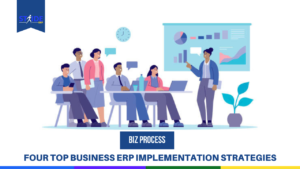
An enterprise resource planning (ERP) system is an important part of modern business operations. An ERP system is a business automation software that integrates your core business processes, from accounting to project management, sales, client relations, inventory, and human resources.
Many businesses see immediate benefits after implementing an ERP solution, like better profit margins, higher chances of achieving goals, and increased efficiency and productivity, while others struggle or encounter problems.
At Stride ERP, we’ve had several rescue missions in the ERP consulting, implementation, and service businesses. We observed that the cause of ERP projects going wrong is either choosing the wrong implementation strategy or skipping steps critical to a successful ERP implementation.
To avoid these mistakes, it is important to understand your implementation strategy options and prepare adequately. In this article, you will learn the four top deployment and implementation strategies, their pros and cons, and the type of businesses each strategy works well for.
- Big-Bang Implementation
Also known as the “Single-Step” method, the big-bang implementation is an ERP implementation strategy where the system is deployed to the entire organization at once. This approach is used when an organization has a single location or department that requires the full functionality of the ERP system.
Often used by small businesses, the advantage of a big-bang implementation is that it allows your business to begin enjoying the solution immediately, like better insights and lower operating costs. However, this approach can be risky because any glitch or error in the system can affect the entire organization. There may also be a temporary drop in productivity as employees get used to the new solution.
Pros
- Immediate ROI
- Single Cost
- High User Adoption rates
Cons
- High Risk
- Employee Resistance
- Rushed Training
- Phased Rollout Implementation
This strategy involves deploying the ERP system in stages. More popular than other strategies, the phased rollout method can be used by both medium and large businesses. It is ideal for any organization with multiple locations or departments that require different functionalities from the ERP system.
In a phased rollout, the ERP solution is implemented considering four factors: time, software module, department, and location. It is advantageous because it allows organizations to test the solution in a controlled environment before implementing it company-wide. This approach also allows for a smoother transition as employees become familiar with the system over time.
Pros
- Low Risk
- Ample Time to Adapt
- Prioritized ROI
Cons
- Slow ROI
- Lack of Urgency to Learn
- Double Subscription Fees (if you were using an ERP before the purchase of a new one)
- Parallel Implementation
A parallel implementation is adopted when a business transitions from an old ERP system to a new one. In this method, the ERP system runs alongside the existing system until the new system is fully functional and tested. Once the new system is in use, the old system phases out. Often used by large organizations, the benefit of a parallel approach is that it allows organizations to test the system in a controlled environment while still using the existing system.
Pros
- Old ERP Provides A Safe Net
- Time To Refine Business Processes
- No Downtime
Cons
- Double Subscription Fees
- Reduced Productivity
- Data Integrity Risks
- Hybrid Implementation
A hybrid approach is a combination of phased rollout and big-bang implementation strategies. This approach can suit any business and involves rolling out the ERP system to a core group of users first and then gradually expanding it to the rest of the organization. The core group of users can provide feedback on the system, refining it before it’s implemented company-wide.
Pros
- Low Risk
- Adaptability
- Customizable Implementation Options
Cons
- Slow Implementation
- Expensive
- Long and Confusing Process
CHOOSING THE RIGHT IMPLEMENTATION STRATEGY
Your choice of implementation strategy should be based on factors like the size and complexity of the organization, the number of users, and the specific needs of the business. Here are some factors to consider when choosing an implementation strategy:
- Business Size And Complexity: Larger organizations with more complex processes may benefit from a phased implementation approach, while smaller organizations may be able to use a big-bang strategy.
- Resources and Time: Phased implementation can be more resource-intensive and time-consuming than the big-bang approach.
- Budget: The phased implementation approach can be more expensive than the big-bang approach, as it requires more resources and time.
- Risk: The big-bang approach carries a higher risk of failure, as any issues that arise during the implementation process can affect the entire organization at once.
- Change Management: Change management is an essential part of any ERP implementation strategy. Businesses must be prepared to manage the changes that come with implementing an ERP system, including changes in processes, workflows, and job roles.
Regardless of the implementation strategy chosen, it is essential to have a clear plan, effective change management, and ongoing support to ensure the successful adoption of your ERP system.
